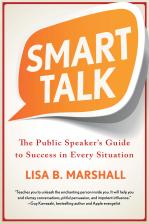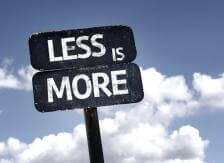In Communication, Less Is More
Communicating simply and effectively is a valuable skill. Today the Public Speaker examines how to say more by actually saying less.
Lisa B. Marshall
Listen
In Communication, Less Is More
-
“Less is more.”
-
“Simplicity is the ultimate sophistication.”
-
“Simplify and add lightness.”
We hear these phrases from time to time, but what exactly do they mean?.
I used to think writing was a lost art, but it’s not so! In our current culture of technology, it seems the written word is more important than ever. Think of all the communicating you do via email, text, and social media. More than ever, we have an audience of readers.
These readers have short attention spans. When it comes to words, often less really is more. Fewer words have more impact. Here are some common ways we communicate with writing and how to keep it short and sweet (or KISS).
Email Communication
I sometimes get impatient when I get a long email.
Why is that? It’s not because I’m in a hurry, it’s just that I’d prefer the writer to be clear and concise.
One way to make your message stand out and not be overwhelming to your recipient is to keep the greeting or introduction short or possibly not even use one at all (depending on your relationship with the person). Usually, one quick sentence is adequate.
Next, in the body of the email, jump right into your question or main point. Visually separate your ideas with a space or bullet points. One giant paragraph can be exhausting! If you have more than one main idea, consider sending separate emails.
End your email with a quick “thanks” or a summary reiterating your main request. Use bolding and liberal spacing to make it easy on the eyes.
For more tips on the do’s and don’ts of email, check out my episode 10 Ways to Annoy Your Colleagues with Email.
Websites and Newsletters
Similarly, with newsletters and websites, liberal spacing, bolded headlines, and using only one or two font types is likely to get you noticed. A website will be more appealing and cohesive with less visual clutter. Make your information more impactful with simple words, repeating phrases, and attractive images.
Think of road signs…You’re more likely to notice the single word CAUTION than if it were mixed in with several other descriptive words.
Your call to action should be a short headline or a one-word attention grabber. You want readers to stop and take notice of your information, so make an impression by making it cleaner and more manageable for the reader.
Think of road signs and safety signs you see everywhere. You’re more likely to notice the single word CAUTION than if it were mixed in with several other fonts and descriptive words. Most people won’t take the time to read a wordy sign, but highlighting one word in bold grabs attention and accomplishes what it’s supposed to.
Verbal Communication
Tip #1: Voicemail

See also: Nuking Voicemail Abusers
In the case of leaving messages for other professionals in a business setting, you might consider jotting down a quick outline before you call. You want to come across as professional and capable. You also don’t want to leave the burden of remembering what you want on the listener. They will most likely forget to address one or more of your questions. So be short, polite, and clear.
Tip #2: Public Speaking
I’ve mentioned the Rule of Three in several earlier episodes. It’s an incredibly effective tool for public speaking. The idea is to limit your important ideas to three. Your audience will be more likely to remember what you’ve said with fewer points. Also, using a clear beginning, middle, and end to your presentation makes it easier for listeners to follow you.
Sometimes repeating a phrase or a single word can be a simple way to add emphasis. I’ve written previously about using short catchphrases to make your point, so be sure to check out my episode Why Everyone Needs a Good Catchphrase .
Tip #3: Interviews/Q&A Sessions
Have you ever watched the President in a press conference? When it is time to take questions from the reporters, some questions are missed or unanswered. Usually it’s the question presented in multiple parts. It’s hard to remember too many questions thrown in at once. Framing the question in multiple parts also gives the interviewee the chance to pick and choose which question is more desirable to answer. This leaves the reporter and the audience hanging. Just remember, as in the case of voicemails, ask and answer your questions one at a time and simply.
See also: How to Prepare and Deliver Media Interviews (Part 1) and (Part 2)
Likewise, if you are the person being interviewed, try to answer the question in a concise manner, and apply the rules of public speaking. Stick to your topic, repeat if necessary, and be direct.
Finally, whether your message is verbal or written, the KISS principle is a great one to follow. Everyone values his/her time, and your recipient will be more responsive if you show that you understand that their time is precious. Decide which ideas you really need to get across and which are just filler or fluff. The bottom line is that you get much more done when you’re clear, concise, and compelling.

This is Lisa B. Marshall, Helping you maximize sales, manage perceptions, and enhance leadership through keynotes, workshops, books, and online courses. Passionate about communication; your success is my business. If you want even more success in your life, I invite you to read my latest book, Smart Talk and listen to my other podcast, Smart Talk: Inspiring Conversations with Exceptional People.
Less is more and annoyed man photos courtesy of Shutterstock.

 “Less is more.”
“Less is more.”
